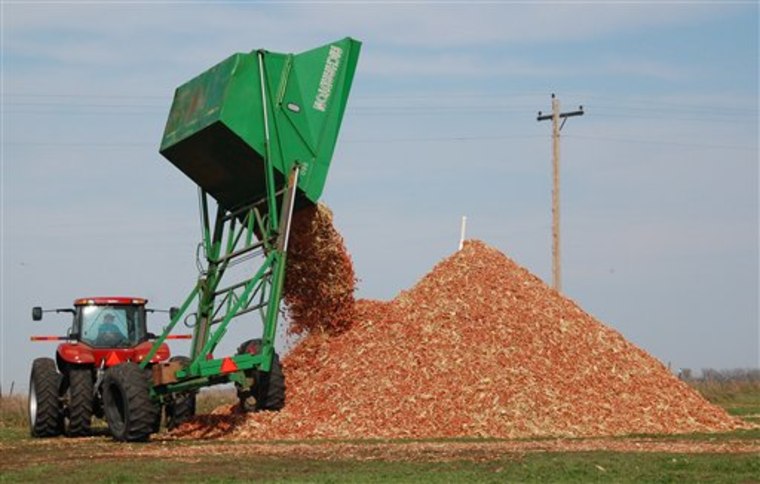Two new technologies offer the promise that corn growers could turn their cobs into cash.
Cobs, the refuse left behind after harvest, are now plowed back into fields. But companies from California and South Dakota plan to start changing that by building two plants in Iowa, one to turn the material into ethanol and another to produce fertilizer.
"We're excited about it," corn farmer Jim Boyer said, "that there's an opportunity for another profit stream off our farm."
Boyer already sells much of the corn from his farm in Ringsted in northern Iowa to a traditional ethanol plant in nearby Emmetsburg. Most ethanol in the U.S. is made from corn kernels.
But a $200 million plant being built by Sioux Falls, S.D.-based Poet Energy will make cellulosic ethanol, which comes from plant material such as cobs, wood chips and switchgrass. About two dozen cellulosic ethanol projects are being developed or built around the country, according to the Renewable Fuels Association.
The projects vary by region, with companies using whatever local crop is available. Louisiana and Florida companies, for instance, are using sugar cane, while one based in Oregon plans to convert poplar trees and wood chips into ethanol.
"There isn't an ethanol producer today that isn't looking at those kinds of biomass materials that can be converted into ethanol," said Matt Hartwig, a spokesman for the association.
In Iowa, it's corn, and a switch from regular to cellulosic could mean more kernels are available for human food and livestock feed.
The push for new ways to produce cellulosic ethanol comes as many ethanol makers are struggling to turn a profit. They've had to drop prices to remain competitive as gas prices have fallen, but the cost of corn used to make ethanol has remained relatively high, said David Swenson, a researcher at Iowa State University.
Some of the largest producers have declared bankruptcy or been sold.
Poet spokesman Nathan Schock said the company hasn't yet figured out how much it will pay farmers, but it could be $30 to $60 per ton for corn stover, which includes cobs and some stalk. An average acre in Iowa yields about 1.5 tons of corn stover.
The company's payments to farmers could be supplemented by the federal government through the Biomass Crop Assistance Program.
Poet's plant in Emmetsburg, about 120 miles northwest of Des Moines, is expected to produce about 25 million gallons of ethanol per year when it opens in 2011. It could generate as much as $10 million per year in extra income for farmers.
Fertilizer plant to be a first
Meanwhile, San Francisco-based SynGest, Inc., plans to build an $80 million facility in Menlo, about 40 miles west of Des Moines, that will be the first to make ammonia fertilizer from corn cobs.
The plant, expected to be completed by fall 2011, will process 130,000 tons of cobs per year into 50,000 tons of fertilizer, or enough for 100,000 acres of corn, SynGest CEO Jack Oswald said. Farmers would get about $50 per ton of cobs.
The company plans to market ammonia fertilizer to nearby farms as alternative to nitrogen fertilizer, which is made from oil. More than half the nation's supply of nitrogen fertilizer is imported, which drives up the price to farmers, Oswald said.
"There's a lot of reasons why this is a smart and valuable thing to do," he said. "This is a huge industry opportunity."
Poet expects $100 million in federal and state aid to build its plant, while SynGest has applied for $40 million in federal aid and additional state help.
Collecting cobs could be costly
Farmers said they'd like to trade their trash for cash, but most lack equipment to easily scoop up cobs. Prototypes for such machines are being built, but they could cost more than the cobs bring in. Boyer said a lot of questions remain.
"If we have another stream of product coming off the field, is it going to take more equipment?" he asked. "Is it going to take more manpower? Are we going to have to store those cobs ourselves or are we going to be able to deliver them to the plant, or is the plant going to come pick them up?"
Clark Bredahl, who raises corn, soybeans and cattle 320 acres near Greenfield, also said he'd need to figure out whether selling his cobs made economic sense.
"If the company is willing to pay enough so that it becomes feasible for farmers to collect the cobs and deliver them to their plant, then that definitely has some promise," he said. "But we don't know what those details will be yet."
